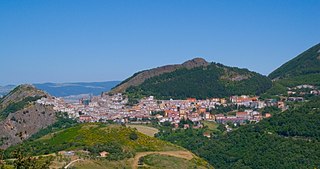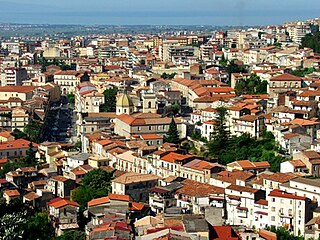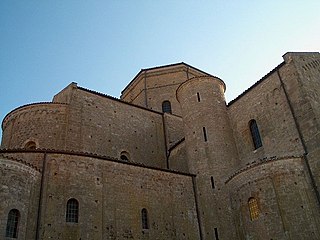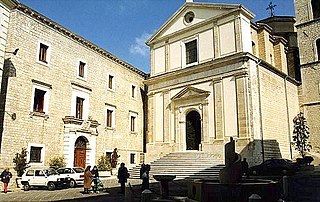
The House of Orsini is an Italian noble family that was one of the most influential princely families in medieval Italy and Renaissance Rome. Members of the Orsini family include five popes: Stephen II (752–757), Paul I (757–767), Celestine III (1191–1198), Nicholas III (1277–1280), and Benedict XIII (1724–1730). In addition, the family included 34 cardinals, numerous condottieri, and other significant political and religious figures.

Reggio di Calabria, commonly and officially referred to as Reggio Calabria, or simply Reggio by its inhabitants, is the largest city in Calabria as well as the seat of the Regional Council of Calabria. It has an estimated population between 150,000 and 200,000 and is the twenty-first most populous city in Italy, after Modena, and the 100th most populated city in Europe. Reggio Calabria is located near the center of the Mediterranean and is known for its climate, ethnic and cultural diversity. It is the third economic centre of mainland Southern Italy. About 560,000 people live in the metropolitan area, recognised in 2015 by Italy as a metropolitan city.

San Fele is a town and comune in the province of Potenza in the Basilicata region of southern Italy.

Muro Lucano is a city and comune in the province of Potenza, in the northern part of the region of Basilicata, southern Italy.

Oria is a town and comune in the Apulia region, in the province of Brindisi, in southern Italy. It is the seat of the Roman Catholic Diocese of Oria.

Lamezia Terme, commonly called Lamezia, is an Italian city and comune of 70,452 inhabitants (2013), in the province of Catanzaro in the Calabria region.

Gravina in Puglia is a town and comune of the Metropolitan City of Bari, Apulia, southern Italy.

Castel Nuovo, often called Maschio Angioino, is a medieval castle located in front of Piazza Municipio and the city hall in central Naples, Campania, Italy. Its scenic location and imposing size makes the castle, first erected in 1279, one of the main architectural landmarks of the city. It was a royal seat for kings of Naples, Aragon and Spain until 1815.

The Spires of Naples are monumental columns in the historic center of the city of Naples, Italy.
The counts of Gravina, later the dukes of Gravina, were medieval rulers of Gravina in Puglia, in the old Kingdom of Sicily and the Kingdom of Naples. The county was settled on various royal favorites, and was held by members of the Neapolitan royal family from about 1300 until 1385. In 1417, it was granted to Francesco Orsini, who was created a duke in 1436; his descendant holds the title today, and represents the remaining branch of the Orsini family. Among the Orsini dukes, Pietro Francesco resigned his temporal dignities in 1667 to become a Dominican, and subsequently ascended the papal throne as Pope Benedict XIII. His nephew, Duke Domenico II, was created cardinal. Francesco also achieved notoriety by being strangled while a captive of Cesare Borgia.

The Archdiocese of Acerenza is a Latin archdiocese of the Catholic Church in southern Italy, included in the provinces of Lecce and Potenza. It has existed as a diocese since the fourth or fifth centuries. In the 11th century it was elevated to an archdiocese. In 1203 it was united with the diocese of Matera to form the Archdiocese of Acerenza and Matera. This was separated again in 1954, recreating the Archdiocese of Acerenza, which briefly became the Diocese of Acerenza in 1976 before reverting to an archdiocese in 1977. Its metropolitan is the Archdiocese of Potenza-Muro Lucano-Marsico Nuovo.

San Paolo Maggiore is a basilica church in Naples, southern Italy, and the burial place of Saint Cajetan, founder of the Theatines. It is located on Piazza Gaetano, about 1-2 blocks north of Via dei Tribunali.

The Archdiocese of Potenza-Muro Lucano-Marsico Nuovo is a Latin diocese of the Catholic Church in Basilicata, southern Italy, created in 1986. In that year the Diocese of Muro Lucano was united into the Archdiocese of Potenza e Marsico Nuovo, which had been elevated to an archdiocese in 1973, and made a metropolitan see in 1976. The historical Diocese of Potenza was united with the Diocese of Marsico Nuovo in 1818.
The Latin Catholic Diocese of Muro Lucano, in the southern Italian region of Basilicata, existed until 1986. In that year it was united into the archdiocese of Potenza-Muro Lucano-Marsico Nuovo.

The Archdiocese of Matera-Irsina is a Latin archdiocese of the Catholic Church in Basilicata, Italy. It has existed under this name since 1986. The archbishop is seated at Matera Cathedral.. It is a suffragan of the Archdiocese of Potenza-Muro Lucano-Marsico Nuovo.
The 1694 Irpinia–Basilicata earthquake occurred on 8 September. It caused widespread damage in the Basilicata and Apulia regions of what was then the Kingdom of Naples, resulting in more than 6,000 casualties. The earthquake occurred at 11:40 UTC and lasted between 30 and 60 seconds.

Castel Sant'Elmo is a medieval fortress located on Vomero Hill adjacent to the Certosa di San Martino, overlooking Naples, Italy. The name "Sant'Elmo" derives from a former 10th-century church dedicated to Sant'Erasmo, shortened to "Ermo" and, finally altered to "Elmo". Located near the upper terminus of the Petraio, one of the city's earliest pedestrian connections between upper and lower Naples, the fortress now serves as a museum, exhibition hall, and offices.

The Palazzo Zevallos Stigliano is a Baroque palace located on Via Toledo number 185 in the quartiere San Ferdinando of central Naples, Italy. It is also called the Palazzo Zevallos or Palazzo Colonna di Stigliano, and since 2014 serves as a museum of artworks, mainly spanning the 17th through the early 20th centuries, sponsored by the Cultural Project of the bank Intesa Sanpaolo. This museum is linked to the Museum or Gallerie di Piazza Scala in Milan and the Museum at Palazzo Leoni Montanari in Vicenza, also owned by the Bank.

Altamura Castle was a castle located in the city of Altamura, now completely demolished. It was located over today's piazza Matteotti and a few remains of it are still visible inside the adjacent buildings, which were built partly with stones and structural elements from the castle. In a warehouse are an ogival arch and some stone coats of arms. A few other remains are found in the adjacent buildings, which were built in the 19th century.
The 1688 Sannio earthquake occurred in the late afternoon of June 5 in the province of Benevento of southern Italy. The moment magnitude is estimated at 7.0, with a Mercalli intensity of XI. It severely damaged numerous towns in a vast area, completely destroying Cerreto Sannita and Guardia Sanframondi. The exact number of victims is unknown, although it is estimated to total approximately 10,000. It is among the most destructive earthquakes in the history of Italy.
















